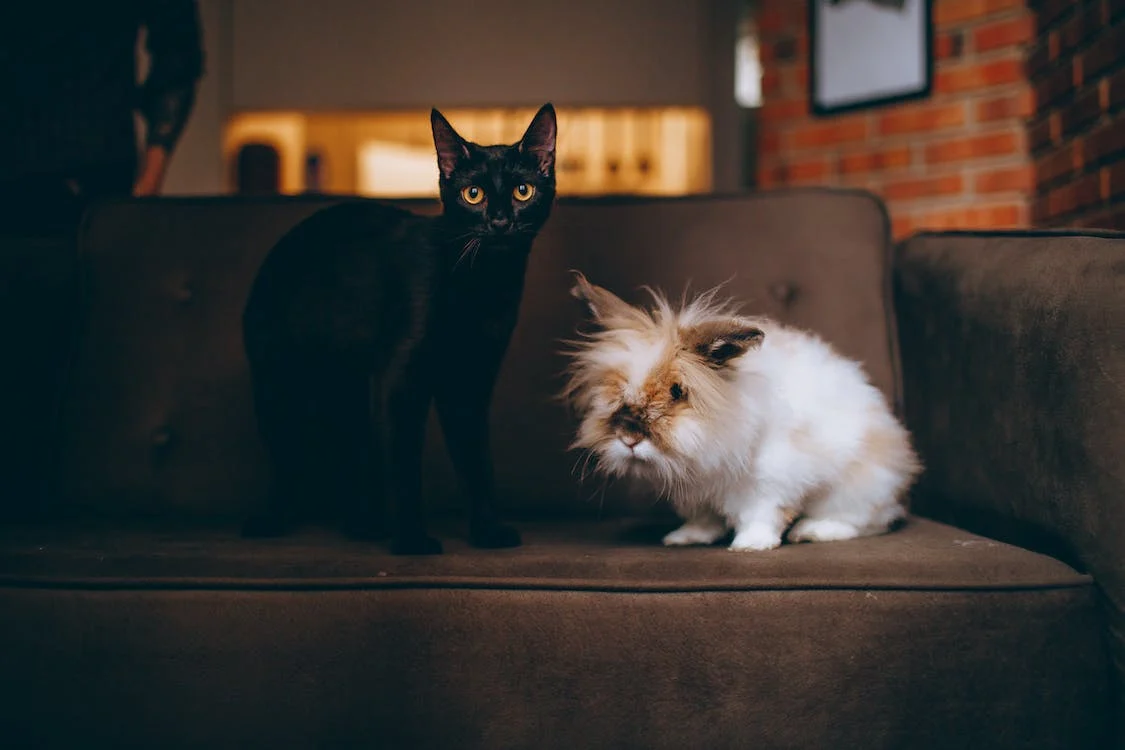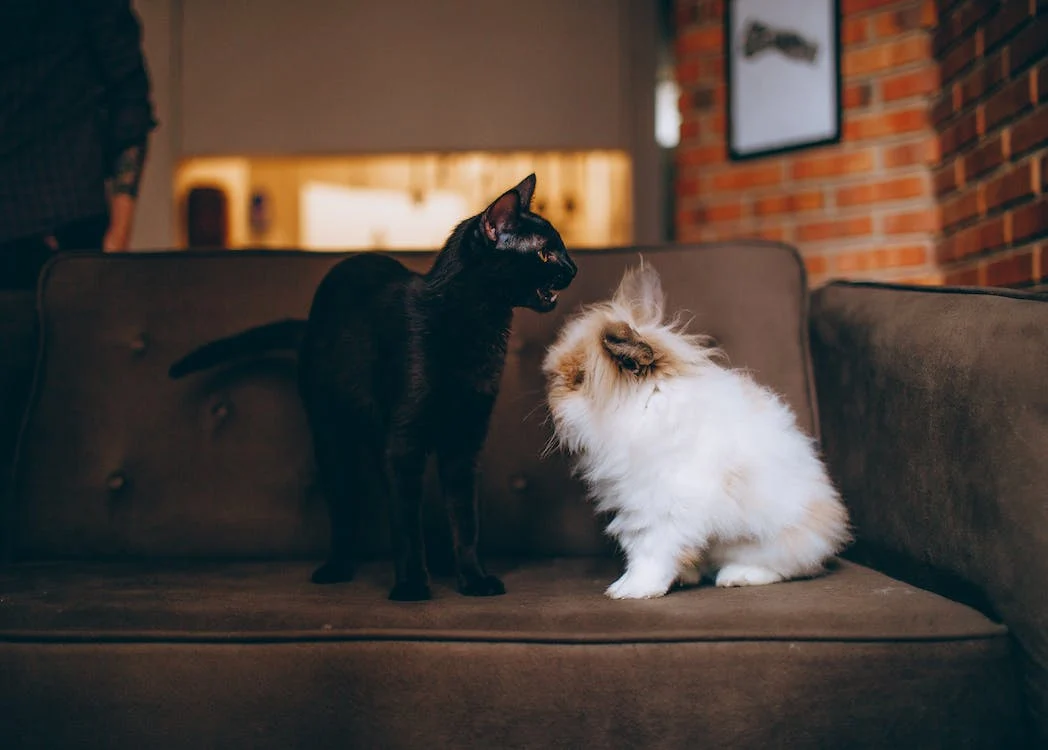
Setting up a Cat/Rabbit Cohabitation
When you love animals, you often have several under the same roof. If they are of the same species, they will “speak” the same language, but what if they are two different species? In the case of the cat and rabbit relationship, it is advisable to proceed only in stages and with caution.
Cats and rabbits: differences and similarities
Of course, the difference is noticeable: the cat is a predator, and the rabbit is the prey. It’s hard to imagine that their instincts could be set aside and a harmonious relationship develop, yet many people report a strong bond between their rabbit(s) and their pet cat(s).
– The cat is a rather solitary, territorial animal, which gets closer to its congeners at the time of reproduction. Domestication has considerably changed things, forcing cats to live on smaller and smaller territories, even to adopt a group life. Without becoming a gregarious animal, it has become much more tolerant of the presence of its fellow creatures and, by extension, of cohabitation with other animals.
– Rabbits are also territorial, but they live in family groups with sometimes many members, so there is a hierarchy and necessary social codes where everyone has his place. As a result, rabbits find it very difficult to live alone, even if it means finding an animal of another species to find a balance close to their optimal living environment.
Rabbits and cats have their frank character, playfulness, and great curiosity in common. Therefore, thanks to the combination of the effect of domestication and the points highlighted above, cohabitation can be envisaged between these so-endearing animals.
Good to know: it is strongly advised, for all social or gregarious animals (i.e., living naturally in a group), never to adopt an individual alone, because even if he is satisfied with the presence of other animals and will find a balance there, he will never have the same codes. This often results in behavioral problems, which, if manageable for small animals, can become catastrophic with larger animals.
Setting up a cat/rabbit cohabitation
Here are a few points to consider and simple advice to give all chances to a successful collocation between cats and rabbits.
Different scenarios
– Don’t introduce a baby rabbit to an adult cat: keep in mind the cat’s hunting instinct. Sometimes, when a cat is nursing, as her maternal instinct is very strong, she may be able to adopt a bunny in her litter of kittens, but this is an exception!
– If the rabbit and cat are both young, they will learn to live together early. In this case, you must be very careful with the kitten’s games, which are always hunting games. This could result in a quasi-permanent aggression of the cat towards the rabbit, in the form of play for the cat, but which would turn into a permanent terror for the bunny.
– The ideal configuration is if a rabbit is already present in the home and a cat is introduced under the same roof. The rabbit will be on its territory and will immediately put the cat on guard, and it may charge the cat or display an intimidating attitude. The cat will soon respect these instructions and not position itself as a predator.
– If the rabbit arrives at the house after the cat, the introduction must be done more gradually by setting up possibilities of withdrawal and protection of the rabbit from the cat. But of course, as no rule is 100% established, in this situation, a rabbit with a strong character may put the cat in its place even if the cat is the “master” of the territory.
Good to know: To put all the odds on your side, you must rely on your knowledge of your pets and observation skills. Each rabbit and each cat has its own character, which will inevitably influence how they behave towards each other.
Preparations

Even before the newcomer’s introduction, you can think about the organization of your home. It might be a good idea for the cat and the rabbit to have a room where they can each have a quiet time and sleep at night.
It is advisable to remove the tips of the cat’s claws and to do the same for the rabbit, which can give very effective pawing. This way, you can avoid injuries they could inflict on each other, even during a game.
First phase: meeting with cage
When the rabbit arrives, you can leave it in a spacious cage so the cat can come and see the rabbit, they will feel each other, and you would already see how they react face to face, but in safety. Then, reverse the roles! Put the cat in its carrier and let the rabbit loose to discover its environment. The same method can be used if the cat is a newcomer.
The more time you take for the cat and rabbit to get to know each other, the more likely their cohabitation will go well. Don’t hesitate to repeat the pattern of the first meeting several times until you are sure that the rabbit and the cat are relaxed.
Second phase: meeting without a cage
If the first stage of the meeting is successful and there are no excessive reactions on either side, move on to the next stage: the meeting without a cage but still in your presence.
– What are the risks? If the rabbit runs away from the cat, the cat may react by running after it. On the contrary, the rabbit may attack the cat. So it’s up to you to see if either is in danger.
– Repeat these encounters every day for a little longer. It’s normal for cats and rabbits to try to intimidate each other or to react defensively. Without worrying, find the balance between letting them get their bearings and not hurting or scaring each other too much. Separate them gently, put the rabbit back in the shelter (or vice versa!), and try the next day again.
– The rabbit, needing to establish a hierarchy, may want to impose itself. Being more phlegmatic, the cat may tend to remain stoic in front of this ball of fur or move away if it doesn’t feel comfortable. Observe their behaviors and adapt the steps according to each one.
Remember, however, not to leave cats and rabbits alone in the house without supervision. This can only be considered after several months or years of perfect harmony.
Good to know: keep in mind the keywords of gentleness, patience, and observation. They can be your guideline to a successful introduction and a harmonious cohabitation. A cat and a rabbit living under the same roof can accept each other, become good companions, or ignore each other. However, they can also fight and fail to find common ground, but cat/rabbit cohabitation is a success in most cases.





